Technical information
Result
Products and construction methods applicable to 「Paving by Unique Equipments」
Refine further
(12 items)
-
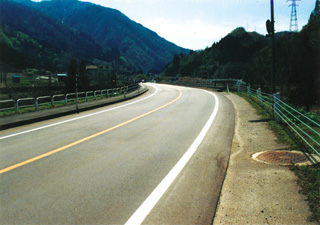
Thin-layer Split (Stone) Mastic Asphalt Pavement Thin-layer SMAC
For repairing cracked road surfaces and stress-relief layers
Thin-layer pavement made with a special asphalt mixture of which Max. Aggregate size is 5 mm. An aggregate structure packed with sand mastic that has been reinforced with vegetable fibers results in excellent flexibility and watertightness.
-
Feature mark :





-
Category :
-
Paving Methods > Roadway > Maintain / Repair >
-
Feature mark :
-
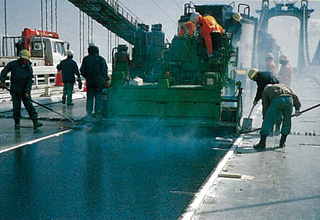
Gussasphalt Pavement GUSSASPHALT
For waterproof layers of steel bridge slabs
This pavement is laid down by pouring a high-temperature, highly fluid gussasphalt mixture. It is generally used for waterproof layers on deck slab pavement for steel bridges. Rolled Gussasphalt for surface layers with pre-coated chips press-fitted to improve flow resistance and slip resistance is also available.
-
Feature mark :

-
Category :
-
Paving Methods > Roadway > Bridge Surfaces / Waterproof >
-
Feature mark :
-
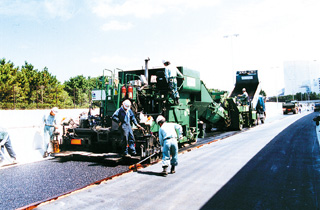
Dual Layer Asphalt Pavement DL PAVE
Realizes structural reinforcement, shortened construction period, and cost reduction
DL Pave is the pavement to be laid two different asphalt mixtures across separate upper and lower layers at the same time and compacted by rollers. For laying the asphalt mixture, it is done by using a two-layer simultaneous paving asphalt paver “DL Paver” and a material feeder “Asphalt Loader.”
-
Feature mark :




-
Category :
-
Paving Methods > Roadway > Construction Technology >
-
Feature mark :
-
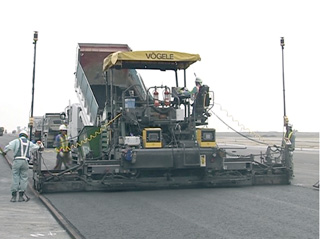
Intelligent Road Construction, GNSS Stringless System NSP System
Improved safety and paving accuracy and can accommodate the centralized management of multiple paving machines
A computerized paving system based on the use of a global navigation satellite system (GNSS) and zone laser technology. Based on 3D design data and position information received from GNSS, paving machines such as motor graders and asphalt pavers are automatically controlled with high accuracy.
-
Feature mark :


-
Category :
-
Paving Methods > Roadway > Construction Technology >
-
Feature mark :
-
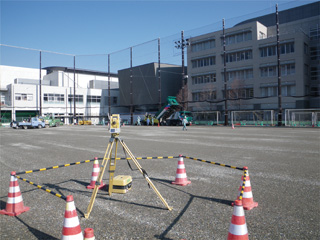
Intelligent Road Construction, Total Station Stringless System TS System
Reduced inspections and improved safety and paving accuracy
This system uses an auto tracking total station to automatically control the height at which pavement is laid down and leveled by paver. As the control range is narrower than that of GNSS technology and the equipment is easy to set up, the system is suitable for rationalizing small- and medium-scale paving operations, reducing the need for skilled labor for such operations, and carrying out high-precision construction work.
-
Feature mark :


-
Category :
-
Paving Methods > Roadway > Construction Technology >
-
Feature mark :
-
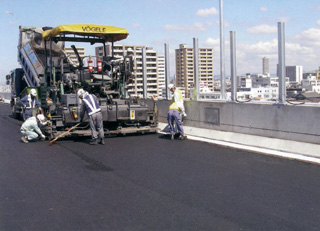
Electromagnetic Induction Pavement Height Automatic Control System NEI System
Improved safety and paving accuracy
This system automatically controls the pavement height on bridge deck slabs by using magnetic fields generated by weak electrical currents. With no need to install string lines to control an asphalt paver, it is possible to improve safety, carry out high-precision paving work, rationalize the work that is performed, and make labor-saving decisions.
-
Feature mark :


-
Category :
-
Paving Methods > Roadway > Construction Technology >
-
Feature mark :
-
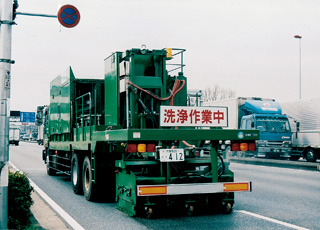
Drainage Pavement Recovery PERVIOUS-CLEAN
Removing void-clogging substances from drainage pavements with high-pressure water to restore their functionality
This is a treatment method to restore the functionality of drainage pavements that have been degraded by clogged voids. Substances trapped in voids are removed with high-pressure water. There are the standard type (rotary injection suction type) and the high speed type (tornado type) drainage pavement function recovery vehicles, which can be used for various road surface conditions.
-
Feature mark :





-
Category :
-
Paving Methods > Roadway > Maintain / Repair >
-
Feature mark :
-
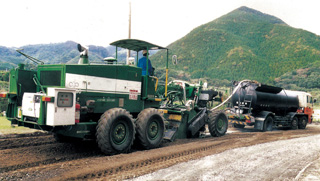
Cold in-place Recycling with Foamed Bitumen FOAMED FRB
Recycling method for promoting environmental conservation and reducing costs
This is a cold in-place recycling method that reclaims old existing asphalt and base course by mixing foamed asphalt and a small amount of cement, and reuses it as a base course for new pavement. This is a more economical pavement repair method than the in-place base recycling using asphalt emulsion or the pavement replacing.
-
Feature mark :





-
Category :
-
Paving Methods > Roadway > Maintain / Repair >
-
Feature mark :
-
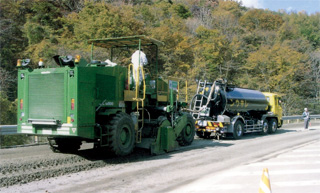
Cold in-place recycling of Consolidated Road Base SUPER FRB
Reclaiming damaged reclaimed base with "Road Recycler"
This is a cold in-place recycling method that reclaims the damaged old base courase which was firmly consolidated due to previous stabilization. The high-performance stabilizer “Road Recycler” can efficiently crush and mix such consolidated existing base courase, which is difficult to do with conventional road stabilizers.
-
Feature mark :





-
Category :
-
Paving Methods > Roadway > Maintain / Repair >
-
Feature mark :
-
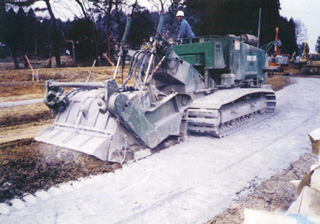
Cold In-place (In situ) Recycling FRB
Economical and environmentally friendly as it reuses existing asphalt pavement.
This is a cold-in-place recycling method in which aged asphalt pavement that has developed alligator cracks is crushed in-place and mixed with the underlying road base material while adding cement, etc. to create a new stabilized base courase.
-
Feature mark :





-
Category :
-
Paving Methods > Roadway > Maintain / Repair >
-
Feature mark :
| Common name | Product name | Overview |
|---|---|---|
| Thin-layer Split (Stone) Mastic Asphalt Pavement | Thin-layer SMAC | Thin-layer pavement made with a special asphalt mixture of which Max. Aggregate size is 5 mm. An aggregate structure packed with sand mastic that has been reinforced with vegetable fibers results in excellent flexibility and watertightness. |
| Gussasphalt Pavement | GUSSASPHALT | This pavement is laid down by pouring a high-temperature, highly fluid gussasphalt mixture. It is generally used for waterproof layers on deck slab pavement for steel bridges. Rolled Gussasphalt for surface layers with pre-coated chips press-fitted to improve flow resistance and slip resistance is also available. |
| Dual Layer Asphalt Pavement | DL PAVE | DL Pave is the pavement to be laid two different asphalt mixtures across separate upper and lower layers at the same time and compacted by rollers. For laying the asphalt mixture, it is done by using a two-layer simultaneous paving asphalt paver “DL Paver” and a material feeder “Asphalt Loader.” |
| Intelligent Road Construction, GNSS Stringless System | NSP System | A computerized paving system based on the use of a global navigation satellite system (GNSS) and zone laser technology. Based on 3D design data and position information received from GNSS, paving machines such as motor graders and asphalt pavers are automatically controlled with high accuracy. |
| Intelligent Road Construction, Total Station Stringless System | TS System | This system uses an auto tracking total station to automatically control the height at which pavement is laid down and leveled by paver. As the control range is narrower than that of GNSS technology and the equipment is easy to set up, the system is suitable for rationalizing small- and medium-scale paving operations, reducing the need for skilled labor for such operations, and carrying out high-precision construction work. |
| Electromagnetic Induction Pavement Height Automatic Control System | NEI System | This system automatically controls the pavement height on bridge deck slabs by using magnetic fields generated by weak electrical currents. With no need to install string lines to control an asphalt paver, it is possible to improve safety, carry out high-precision paving work, rationalize the work that is performed, and make labor-saving decisions. |
| Drainage Pavement Recovery | PERVIOUS-CLEAN | This is a treatment method to restore the functionality of drainage pavements that have been degraded by clogged voids. Substances trapped in voids are removed with high-pressure water. There are the standard type (rotary injection suction type) and the high speed type (tornado type) drainage pavement function recovery vehicles, which can be used for various road surface conditions. |
| Cold in-place Recycling with Foamed Bitumen | FOAMED FRB | This is a cold in-place recycling method that reclaims old existing asphalt and base course by mixing foamed asphalt and a small amount of cement, and reuses it as a base course for new pavement. This is a more economical pavement repair method than the in-place base recycling using asphalt emulsion or the pavement replacing. |
| Cold in-place recycling of Consolidated Road Base | SUPER FRB | This is a cold in-place recycling method that reclaims the damaged old base courase which was firmly consolidated due to previous stabilization. The high-performance stabilizer “Road Recycler” can efficiently crush and mix such consolidated existing base courase, which is difficult to do with conventional road stabilizers. |
| Cold In-place (In situ) Recycling | FRB | This is a cold-in-place recycling method in which aged asphalt pavement that has developed alligator cracks is crushed in-place and mixed with the underlying road base material while adding cement, etc. to create a new stabilized base courase. |
(12 items)
